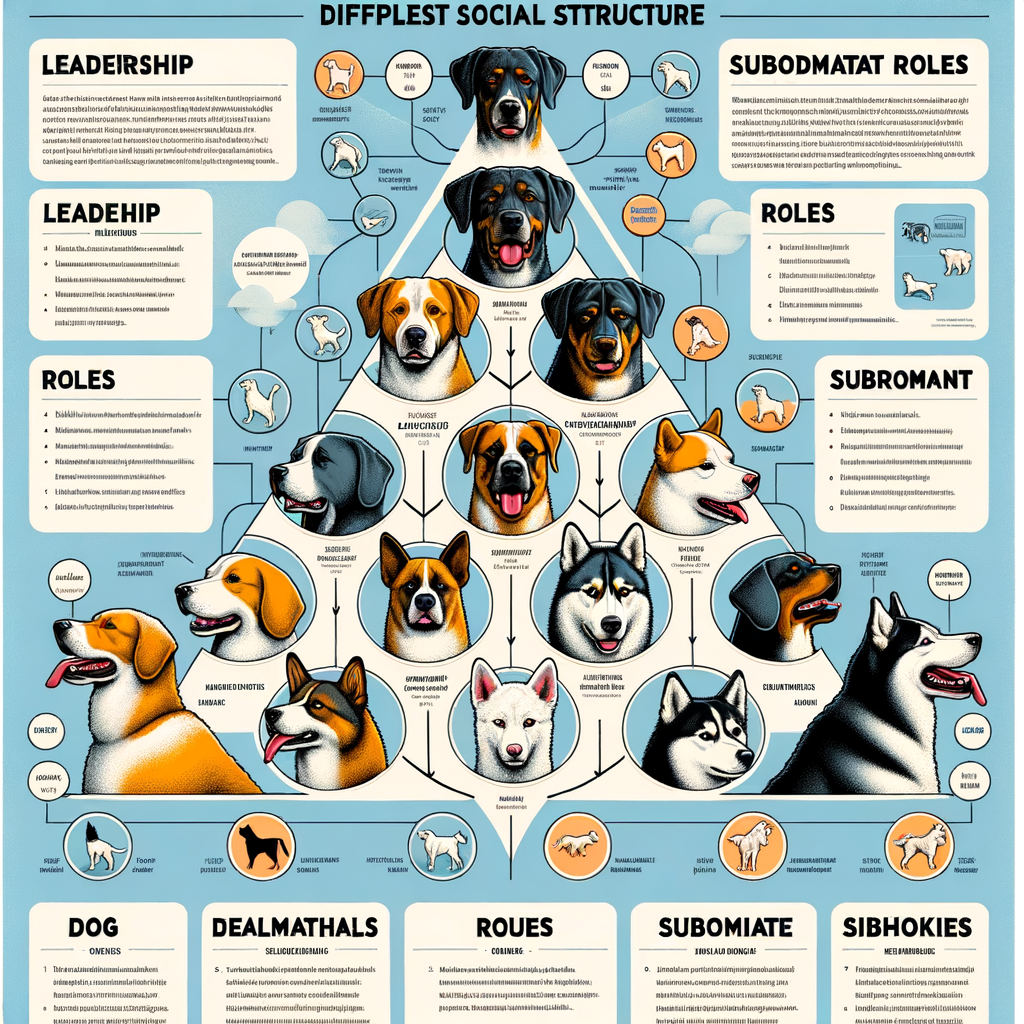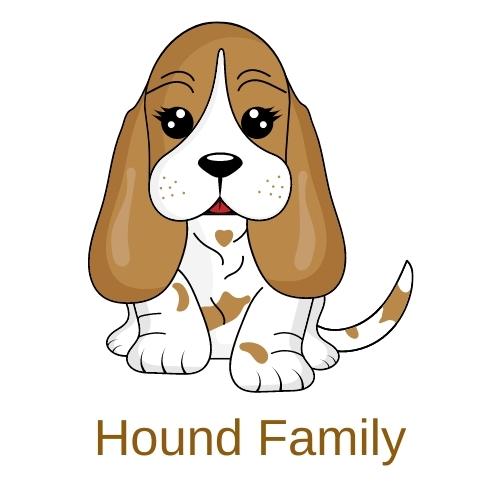
Introduction to Pack Dynamics in Dogs
When we look at our furry friends, we often forget that they come from a long line of wild ancestors. These ancestors lived in packs, and their social structure was crucial to their survival. In this post, we’ll delve into the fascinating world of pack dynamics in dogs.
- Understanding the social structure of dogs
- Importance of studying pack dynamics in dogs
Dogs, like their wild counterparts, have a complex social structure. This structure is often referred to as a ‘pack’. A pack is not just a group of dogs living together. It’s a tightly-knit community with rules and roles that each member must adhere to. The pack is led by an alpha dog, who makes the decisions and maintains order. Following the alpha are the beta dogs, who act as second-in-command. At the bottom of the hierarchy are the omega dogs, who are often the most submissive.
Understanding pack dynamics is not just interesting, it’s also crucial for any dog owner. It helps us understand our pets better, and allows us to provide them with a more natural and comfortable environment. For instance, knowing that dogs are pack animals can explain why your dog follows you around the house, or why they get anxious when left alone. It can also help with training, as dogs are more likely to obey commands from those they see as their pack leaders.
By studying pack dynamics, we can also learn more about dog behavior in general. For instance, we can understand why some dogs are more aggressive, while others are more submissive. We can also learn how to prevent and resolve conflicts within a pack, and how to introduce a new dog into an existing pack.
In the following sections, we’ll delve deeper into the hierarchy within a dog pack, the behavior of hounds in a pack, and the overall social structure of dogs. So, stay tuned to learn more about the fascinating world of pack dynamics in dogs.
Understanding Dog Hierarchy
When it comes to understanding dog behavior, it’s essential to comprehend their social structure. Dogs, like wolves, live in packs and have a specific hierarchy. This hierarchy plays a significant role in how dogs interact with each other and their human family members. Let’s delve into the key elements of a dog pack hierarchy.
Key Elements of Dog Pack Hierarchy
Typically, a dog pack hierarchy consists of three main roles: Alpha, Beta, and Omega. Each role has its unique characteristics and responsibilities within the pack.
- Alpha:
- Beta:
- Omega:
The Alpha dog is the leader of the pack. This dog makes decisions, leads the pack, and maintains order. Alphas are usually the strongest and most confident dogs in the pack. They are responsible for the safety and well-being of the pack members. An Alpha dog will display dominant behaviors like maintaining a high tail and head position, leading the way on walks, and eating first during meal times.
The Beta dogs are the second in command in the dog pack hierarchy. They are subordinate to the Alpha but still hold a higher rank than the rest of the pack. Beta dogs are often seen as the “middle children” of the pack. They will follow the Alpha’s lead but will also take charge if the Alpha is not present. Beta dogs may exhibit both dominant and submissive behaviors depending on their interaction with the Alpha or other pack members.
The Omega dogs are at the bottom of the pack hierarchy. They are often the least confident and most submissive dogs in the pack. Omega dogs usually eat last and give way to the Alpha and Beta dogs. Despite their low rank, Omega dogs play a crucial role in maintaining harmony within the pack by diffusing tension and conflict.
Understanding these roles can help dog owners better manage their pets and ensure a harmonious and balanced home environment. Remember, a happy pack is a happy home!
Factors Influencing Dog Social Hierarchy
Just like humans, dogs have a social structure that helps maintain order and harmony within their packs. Several factors influence this hierarchy, including age, size, temperament, and sex. Let’s delve into how these factors play a role in shaping the social hierarchy among dogs.
- Age
- Size
- Temperament
- Sex
Age plays a significant role in dog social hierarchy. Older dogs are often seen as the leaders of the pack. They have more experience and wisdom, which younger dogs respect. However, as dogs age and their physical strength wanes, younger, stronger dogs may challenge their authority.
Size is another important factor in dog social hierarchy. Larger dogs often dominate smaller ones, primarily because of their physical strength and intimidating presence. However, size isn’t everything. A smaller dog with a strong personality can also hold a high position in the pack.
Temperament significantly influences a dog’s position in the social hierarchy. Dogs with a calm, confident, and assertive temperament often hold higher positions. They can lead without resorting to aggression, which earns them respect from other dogs. On the other hand, anxious, fearful, or overly aggressive dogs often find themselves lower in the hierarchy.
Sex can also influence a dog’s position in the social hierarchy. In some packs, males may be dominant, while in others, females may hold the top spot. It often depends on the individual dog’s personality and the specific dynamics of the pack.
In conclusion, understanding the factors that influence dog social hierarchy can help us better understand our furry friends and their behavior. It can also assist us in creating a harmonious environment for them, whether at home or in a multi-dog household.
Hound Pack Behavior
Understanding the behavior of hound packs is crucial for anyone who interacts with these animals. This section will explore the common behaviors seen in hound packs, including leadership, submission, play, and conflict.
Common Behaviors in Hound Pack
Let’s delve into the four key behaviors that are commonly observed in hound packs.
- Leadership
Leadership is a significant aspect of hound pack behavior. The leader, often referred to as the ‘alpha’, is the dog that makes decisions for the pack. This dog is usually the strongest and most experienced member of the pack. They lead the pack during hunts and make decisions that ensure the safety and well-being of the group.
- Submission
Submission is another behavior commonly seen in hound packs. This behavior is exhibited by the less dominant dogs in the pack. By showing submission, these dogs acknowledge the authority of the alpha. This behavior helps maintain harmony within the pack and prevents unnecessary conflicts.
- Play
Play is an essential part of a hound’s life. It is not only a source of enjoyment but also a way for dogs to learn important skills and behaviors. During play, hounds learn how to communicate with each other, understand their place in the pack, and develop their hunting skills.
- Conflict
Conflicts do occur within hound packs, especially when a member challenges the authority of the alpha or when resources are scarce. However, these conflicts are usually resolved quickly and rarely result in serious harm. The alpha’s role is crucial in managing these conflicts and maintaining order within the pack.
In conclusion, understanding these behaviors can help us interact better with hounds and ensure their well-being. Remember, every dog is unique, and while these behaviors are common, they may vary from pack to pack and dog to dog.
Understanding Canine Pack Dynamics
When it comes to understanding canine pack dynamics, there are three key factors to consider: the role of scent, communication through body language, and the importance of play. Let’s delve into each of these aspects.
- Role of Scent in Pack Dynamics
Have you ever noticed how dogs sniff each other when they meet? This is because scent plays a crucial role in canine communication. Dogs have an extraordinary sense of smell, which they use to gather information about their surroundings and other dogs. In a pack, dogs use scent to identify each other and establish hierarchy. For example, the pack leader’s scent is usually the strongest, signaling their dominance to other dogs.
- Communication through Body Language
Just like humans, dogs also communicate a lot through body language. A dog’s posture, tail position, ear movement, and even the way they wag their tail can convey a range of emotions and intentions. In a pack, dogs use body language to express dominance, submission, playfulness, and aggression. Understanding these signals can help us better understand the dynamics within a canine pack.
- Importance of Play in Pack Dynamics
Play is not just fun for dogs; it’s also an essential part of their social interactions. In a pack, dogs engage in play to strengthen social bonds, establish hierarchy, and practice hunting skills. Play also helps diffuse tension and prevent conflicts within the pack. Therefore, observing how dogs play can provide valuable insights into their pack dynamics.
| Key Aspect | Description |
|---|---|
| Role of Scent | Used for identification and establishing hierarchy within the pack. |
| Body Language | Conveys emotions and intentions, used for expressing dominance, submission, playfulness, and aggression. |
| Play | Strengthens social bonds, establishes hierarchy, practices hunting skills, diffuses tension, and prevents conflicts. |
In conclusion, understanding canine pack dynamics involves recognizing the role of scent, interpreting body language, and appreciating the importance of play. By understanding these aspects, we can better understand our furry friends and their social behaviors.
Canine Social Structure
Understanding the social structure of canines, particularly dogs, can be quite enlightening. One of the best ways to grasp this concept is by studying the social structure of a wolf pack, which shares many similarities with that of domestic dogs.
Case Study: Wolf Pack Social Structure
Wolf packs operate on a hierarchical system. This hierarchy is not only fascinating but also provides valuable insights into the behavior of domestic dogs. Let’s delve into the key roles within a wolf pack:
- Alpha Pair: At the top of the hierarchy, we have the alpha pair, usually a male and female, who lead the pack. They are the decision-makers and are responsible for the safety and well-being of the pack. The alpha pair are the only wolves that breed and produce pups in the pack, ensuring the survival of the pack.
- Mid-ranking Wolves: These are the wolves that fall in the middle of the pack hierarchy. They follow the alpha pair’s commands and contribute to hunting, territory defense, and pup rearing. Their role is crucial for the smooth functioning of the pack.
- Omega Wolf: At the bottom of the hierarchy is the omega wolf. This wolf is often the target of aggression from other pack members. Despite this, the omega wolf plays a vital role in maintaining harmony within the pack by diffusing tension and conflict.
Understanding these roles within a wolf pack can help us better understand the behavior and social dynamics of our domestic dogs. Dogs, like wolves, are social creatures and often display similar hierarchical behavior, especially when living in a multi-dog household.
Comparing Wolf and Dog Social Structures
Both wolves and dogs are social animals, meaning they like to live and work together in groups. But how do their social structures compare? Let’s take a closer look.
- Similarities
- Differences
Wolves and dogs share some similarities in their social structures. Both species live in packs, which are like big families. The pack is led by an alpha pair, which is the top dog (or wolf) and his or her mate. They make the big decisions for the pack, like where to hunt or when to move to a new home. The rest of the pack is made up of their children and other family members.
Another similarity is the way they communicate. Both wolves and dogs use body language, sounds, and smells to talk to each other. For example, a wagging tail usually means they’re happy, while a growl can mean they’re angry or scared.
While there are similarities, there are also some important differences between wolf and dog social structures. One big difference is the size of their packs. Wolf packs can have up to 20 members, while dog packs are usually smaller.
Another difference is how they behave in their packs. Wolves have a strict hierarchy, with the alpha pair at the top and an omega wolf at the bottom. The omega wolf is often picked on by the others. Dogs, on the other hand, have a more flexible social structure. They still have leaders, but they don’t usually have an omega dog.
Lastly, while both wolves and dogs can be territorial, wolves are more likely to defend their territory from other packs. Dogs are more likely to share their territory with other dogs, especially if they’re familiar with them.
In conclusion, while wolves and dogs share some similarities in their social structures, they also have some key differences. Understanding these can help us better understand and care for our canine friends.
Hound Behavior Analysis
When it comes to understanding hound behavior, it’s important to delve into the key aspects that shape their actions and reactions. This includes understanding dominance, the role of submission in pack dynamics, and the importance of socialization.
Key Takeaways from Hound Behavior Analysis
Let’s explore these key takeaways in more detail:
- Understanding Dominance: Dominance is a significant factor in hound behavior. In a pack, there’s usually a dominant dog, often referred to as the ‘alpha’. This dog takes the lead in activities and makes decisions for the pack. It’s not about being the biggest or strongest, but about confidence and control. Understanding this aspect can help in managing your hound’s behavior effectively.
- Role of Submission in Pack Dynamics: Just as there are dominant dogs, there are also submissive ones. These dogs yield to the alpha, showing their submission through body language like lowered tails and avoiding direct eye contact. This submission helps maintain peace within the pack and is a crucial aspect of hound behavior.
- Importance of Socialization: Socialization is vital for a hound’s behavioral development. It involves exposing the dog to different environments, people, and other animals, which helps them learn how to behave appropriately. A well-socialized hound is typically more comfortable in various situations and exhibits less problematic behavior.
Understanding these key aspects of hound behavior can provide valuable insights into why dogs act the way they do and how to interact with them effectively. Whether you’re a dog owner, a trainer, or just a dog lover, this knowledge can enhance your relationship with these wonderful creatures.
Practical Applications of Hound Behavior Analysis
Understanding hound behavior is not just for academic or research purposes. It has practical applications that can significantly improve the quality of life for both dogs and their owners. Let’s delve into three key areas where hound behavior analysis can be applied:
- Training
Training is a crucial part of raising a well-behaved and happy dog. By understanding hound behavior, you can tailor your training methods to suit your dog’s natural instincts and behaviors. For instance, hounds are known for their keen sense of smell. Incorporating scent-based activities in training can make the process more engaging and effective for them.
Moreover, understanding dominance and submission in pack dynamics can help you establish a healthy relationship with your dog. You can position yourself as the pack leader, guiding your dog’s behavior without resorting to harsh disciplinary measures.
- Socialization
Socialization is another critical area where hound behavior analysis comes into play. Dogs, like humans, need to interact with their peers to develop social skills. Understanding the importance of socialization in pack dynamics can help you provide your dog with the right social experiences.
For example, exposing your hound to different environments, people, and other dogs at an early age can help them become more confident and well-adjusted adults. Remember, each dog is unique, and their socialization needs may vary based on their behavior patterns.
- Behavior Correction
Finally, hound behavior analysis is instrumental in behavior correction. If your dog develops undesirable behaviors, understanding why they are behaving that way is the first step towards correcting it. For instance, a hound might start digging excessively due to boredom or lack of exercise. By addressing the root cause, you can correct the behavior more effectively than by simply punishing the dog.
Remember, patience and consistency are key in behavior correction. It might take time, but with a proper understanding of hound behavior, you can guide your dog towards better habits.
In conclusion, hound behavior analysis is not just an academic topic. It has real-world applications that can make a significant difference in the lives of dogs and their owners. By understanding your hound’s behavior, you can provide them with a happier, healthier, and more fulfilling life.
Conclusion: Understanding Canine Pack Dynamics
In conclusion, understanding canine pack dynamics is not just fascinating, it’s essential for anyone who interacts with dogs regularly. Whether you’re a dog owner, a trainer, or simply a dog lover, gaining a deep understanding of how dogs interact with each other can greatly improve your relationship with them.
- Importance of understanding dog social hierarchy
Understanding the social hierarchy of dogs is crucial for several reasons. Firstly, it helps us comprehend why dogs behave the way they do. For instance, why does one dog always seem to lead the others at the park? Why does your dog behave differently around different dogs? These are all questions that can be answered by understanding dog social hierarchy.
Secondly, understanding dog social hierarchy can help prevent conflicts between dogs. By recognizing the signs of a potential power struggle or disagreement, you can intervene before things escalate. This is particularly important for dog owners with multiple dogs or those who frequently visit dog parks.
- Implications for dog owners and trainers
For dog owners and trainers, understanding canine pack dynamics can have significant implications. It can inform training methods, help manage behavior problems, and improve the overall relationship between dogs and humans.
For instance, knowing that dogs are pack animals and understanding their social structure can help trainers use methods that work with these instincts rather than against them. This can lead to more effective training and happier, better-behaved dogs.
Furthermore, understanding canine pack dynamics can help dog owners better meet their dogs’ needs. For example, knowing that dogs need a clear leader can help owners establish themselves as the pack leader, providing their dogs with the structure and guidance they crave.
In conclusion, understanding canine pack dynamics is a vital part of being a responsible and effective dog owner or trainer. By taking the time to learn about these dynamics, you can improve your relationship with your dog and help them live a happier, healthier life.








